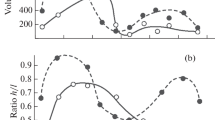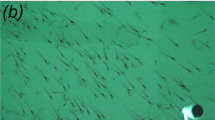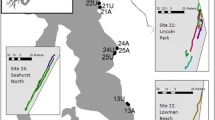Abstract
Many small pelagic fishes obligately form schools; some of these schools reach remarkable sizes. Although the school is a fundamental and important ecological unit and is the site of biological interactions such as competition and predation, information on schooling processes in the field remains scarce. Here, we examined the quantitative relationships between population density and school size, the number of schools, and other school characteristics (i.e. packing density, volume, and cross-sectional area) in three species of small pelagic fishes: Japanese anchovy Engraulis japonicus, Japanese sardine Sardinops melanostictus, and chub mackerel Scomber japonicus. We found that school size increased almost linearly with population density, whereas the number of schools and other characteristics increased non-linearly with population density, whereby the rate of increase slowed radically as population density increased. These results indicate that, at low population densities, an increase in density causes an increase in both school size and the number of schools, whereas at higher population densities, an increase in density triggers the formation of larger schools rather than more schools. Furthermore, we found that the shapes of the relationships of all school characteristics with population density differed amongst species. Our results indicate that the schooling behaviour of small pelagic fishes is density-dependent, and responses to changes in density are species-specific. Our results provide insight into how biological interactions such as intra- and inter-specific competition and predator–prey interactions mediate the density-dependent processes that underlie the population dynamics and community structure of small pelagic fishes in marine ecosystems.







Similar content being viewed by others
References
Aronica S, Fontana I, Giacalone G et al (2019) Identifying small pelagic Mediterranean fish schools from acoustic and environmental data using optimized artificial neural networks. Ecol Inform 50:149–161. https://doi.org/10.1016/j.ecoinf.2018.12.007
Bakun A (2006) Wasp-waist populations and marine ecosystem dynamics: navigating the “predator pit” topographies. Prog Oceanogr 68:271–288. https://doi.org/10.1016/j.pocean.2006.02.004
Barange M (1994) Acoustic identification, classification and structure of biological patchiness on the edge of the Agulhas Bank and its relation to frontal features. South African J Mar Sci 14:333–347. https://doi.org/10.2989/025776194784286969
Beauchamp G (2011) Fit of aggregation models to the distribution of group sizes in Northwest Atlantic seabirds. Mar Ecol Prog Ser 425:261–268. https://doi.org/10.3354/meps09022
Beauchamp G (2011) Functional relationship between group size and population density in Northwest Atlantic seabirds. Mar Ecol Prog Ser 435:225–233. https://doi.org/10.3354/meps09239
Beauchamp G (2014) Social predation: how groupliving benefits predators and prey. Academic Press, London, UK
Borner KK, Krause S, Mehner T et al (2015) Turbidity affects social dynamics in Trinidadian guppies. Behav Ecol Sociobiol 69:645–651. https://doi.org/10.1007/s00265-015-1875-3
Brierley AS, Cox MJ (2015) Fewer but not smaller schools in declining fish and krill populations. Curr Biol 25:75–79. https://doi.org/10.1016/j.cub.2014.10.062
Canales TM, Delius GW, Law R (2020) Regulation of fish stocks without stock–recruitment relationships: the case of small pelagic fish. Fish Fish 21:857–871. https://doi.org/10.1111/faf.12465
Caro T (2005) Antipredator defenses in birds and mammals. University of Chicago Press, Chicago, IL
Carpenter B, Gelman A, Hoffman MD, et al (2017) Stan: a probabilistic programming language. J Stat Softw 76: https://doi.org/10.18637/jss.v076.i01
Chen R, Spiegel O, Bartan Y, Nathan R (2022) Resource limitation drives fission–fusion dynamics of group composition and size in a social bird. Anim Behav 191:15–32. https://doi.org/10.1016/J.ANBEHAV.2022.06.003
Coetzee J (2000) Use of a Shoal Analysis and Patch Estimation System (SHAPES) to characterise sardine schools. Aquat Living Resour 13:1–10. https://doi.org/10.1016/S0990-7440(00)00139-X
Croft DP, Krause J, Couzin ID, Pitcher TJ (2003) When fish shoals meet: outcomes for evolution and fisheries. Fish Fish 4:138–146. https://doi.org/10.1046/j.1467-2979.2003.00113.x
Cury P, Bakun A, Crawford RJM et al (2000) Small pelagics in upwelling systems: patterns of interaction and structural changes in “wasp-waist” ecosystems. ICES J Mar Sci 57:603–618. https://doi.org/10.1006/jmsc.2000.0712
D’Elia M, Patti B, Bonanno A et al (2014) Analysis of backscatter properties and application of classification procedures for the identification of small pelagic fish species in the Central Mediterranean. Fish Res 149:33–42. https://doi.org/10.1016/j.fishres.2013.08.006
Dalziel BD, Novak M, Watson JR, Ellner SP (2021) Collective behaviour can stabilize ecosystems. Nat Ecol Evol 5:1435–1440. https://doi.org/10.1038/s41559-021-01517-w
Erisman BE, Allen LG, Claisse JT et al (2011) The illusion of plenty: hyperstability masks collapses in two recreational fisheries that target fish spawning aggregations. Can J Fish Aquat Sci 68:1705–1716. https://doi.org/10.1139/f2011-090
Fernandes PG (2009) Classification trees for species identification of fish-school echotraces. ICES J Mar Sci 66:1073–1080. https://doi.org/10.1093/icesjms/fsp060
Foote KG (1987) Fish target strengths for use in echo integrator surveys. J Acoust Soc Am 82:981–987. https://doi.org/10.1121/1.395298
Francois RE, Garrison GR (1982) Sound absorption based on ocean measurements. Part II: boric acid contribution and equation for total absorption. J Acoust Soc Am 72:1879–1890. https://doi.org/10.1121/1.388673
Furuichi S, Kamimura Y, Yukami R (2021) Length–length and length–weight relationships for four dominant small pelagic fishes in the Kuroshio-Oyashio current system. Thalass an Int J Mar Sci 37:651–657. https://doi.org/10.1007/S41208-021-00300-9
Griesser M, Ma Q, Webber S et al (2011) Understanding animal group-size distributions. PLoS ONE 6:e23438. https://doi.org/10.1371/journal.pone.0023438
Gueron S, Levin SA (1995) The dynamics of group formation. Math Biosci 128:243–264. https://doi.org/10.1016/0025-5564(94)00074-A
Hamilton WD (1971) Geometry for the selfish herd. J Theor Biol 31:295–311. https://doi.org/10.1016/0022-5193(71)90189-5
Hansen TF, Stenseth NC, Henttonen H, Tast J (1999) Interspecific and intraspecific competition as causes of direct and delayed density dependence in a fluctuating vole population. Proc Natl Acad Sci USA 96:986–991. https://doi.org/10.1073/pnas.96.3.986
Hensor E, Couzin ID, James R, Krause J (2005) Modelling density-dependent fish shoal distributions in the laboratory and field. Oikos 110:344–352. https://doi.org/10.1111/j.0030-1299.2005.13513.x
Hoare DJ, Krause J, Peuhkuri N, Godin J-GJ (2000) Body size and shoaling in fish. J Fish Biol 57:1351–1366. https://doi.org/10.1111/j.1095-8649.2000.tb02217.x
Holubová M, Čech M, Vašek M, Peterka J (2019) Density dependent attributes of fish aggregative behaviour. PeerJ 7:e6378. https://doi.org/10.7717/peerj.6378
Holubová M, Čech M, Vašek M, Peterka J (2019) On the use of a visual census in surveying fish communities in lentic water bodies. Ecol Indic 105:1–5. https://doi.org/10.1016/J.ECOLIND.2019.05.042
Janson C (1985) Aggresive competition and individual food consumption in wild brown capuchin monkeys (Cebus apella). Behav Ecol Sociobiol 18:125–138. https://doi.org/10.1007/BF00299041
Janson CH (1988) Food competition in brown capuchin monkeys (Cebus apella): quantitative effects of group size and tree productivity. Behaviour 105:53–76. https://doi.org/10.1163/156853988X00449
Jech JM, Michaels WL (2006) A multifrequency method to classify and evaluate fisheries acoustics data. Can J Fish Aquat Sci 63:2225–2235. https://doi.org/10.1139/F06-126
Jech JM, Stroman F (2012) Aggregative patterns of pre-spawning Atlantic herring on Georges Bank from 1999–2010. Aquat Living Resour 25:1–14
Jenkins TM, Diehl S, Kratz KW, Cooper SD (1999) Effects of population density on individual growth of brown trout in streams. Ecology 80:941–956. https://doi.org/10.1890/0012-9658(1999)080[0941:EOPDOI]2.0.CO;2
Kamimura Y, Taga M, Yukami R et al (2021) Intra- and inter-specific density dependence of body condition, growth, and habitat temperature in chub mackerel (Scomber japonicus). ICES J Mar Sci 78:3254–3264. https://doi.org/10.1093/ICESJMS/FSAB191
Kamimura Y, Tadokoro K, Furuichi S, Yukami R (2022) Stronger density-dependent growth of Japanese sardine with lower food availability: comparison of growth and zooplankton biomass between a historical and current stock-increase period in the western North Pacific. Fish Res 255:106461. https://doi.org/10.1016/J.FISHRES.2022.106461
Krause J, Ruxton GD (2002) Living in groups. Oxford University Press, Oxford, UK
Li A, Richardson JML, Helen Rodd F (2022) Shoaling in the Trinidadian guppy: costs, benefits, and plasticity in response to an ambush predator. Behav Ecol 33:758–766. https://doi.org/10.1093/BEHECO/ARAC038
Lima SL (1995) Back to the basics of anti-predatory vigilance: the group-size effect. Anim Behav 49:11–20. https://doi.org/10.1016/0003-3472(95)80149-9
Mackenzie KV (1981) Nine-term equation for sound speed in the oceans. J Acoust Soc Am 70:807–812. https://doi.org/10.1121/1.386920
Makris NC, Ratilal P, Symonds DT et al (2006) Fish population and behavior revealed by instantaneous continental shelf-scale imaging. Science 311:660–663. https://doi.org/10.1126/science.1121756
Makris NC, Ratilal P, Jagannathan S et al (2009) Critical population density triggers rapid formation of vast oceanic fish shoals. Science 323:1734–1737. https://doi.org/10.1126/science.1169441
Maury O (2017) Can schooling regulate marine populations and ecosystems? Prog Oceanogr 156:91–103. https://doi.org/10.1016/j.pocean.2017.06.003
Maury O, Poggiale JC (2013) From individuals to populations to communities: a dynamic energy budget model of marine ecosystem size-spectrum including life history diversity. J Theor Biol 324:52–71. https://doi.org/10.1016/j.jtbi.2013.01.018
Misund O (1993) Dynamics of moving masses: variability in packing density, shape, and size among herring, sprat, and saithe schools. ICES J Mar Sci 50:145–160. https://doi.org/10.1006/jmsc.1993.1016
Niwa H-S (1998) School size statistics of fish. J Theor Biol 195:351–361. https://doi.org/10.1006/jtbi.1998.0801
Niwa H-S (2004) Space-irrelevant scaling law for fish school sizes. J Theor Biol 228:347–357. https://doi.org/10.1016/j.jtbi.2004.01.011
Paramo J, Bertrand S, Villalobos H, Gerlotto F (2007) A three-dimensional approach to school typology using vertical scanning multibeam sonar. Fish Res 84:171–179. https://doi.org/10.1016/j.fishres.2006.10.023
Pavlov DS, Kasumyan AO (2000) Patterns and mechanisms of schooling behavior in fish: a review. J Ichthyol 40:S163
Pépin D, Gerard JF (2008) Group dynamics and local population density dependence of group size in the Pyrenean chamois, Rupicapra pyrenaica. Anim Behav 75:361–369. https://doi.org/10.1016/j.anbehav.2006.09.030
Petitgas P, Reid D, Carrera P et al (2001) On the relation between schools, clusters of schools, and abundance in pelagic fish stocks. ICES J Mar Sci 58:1150–1160. https://doi.org/10.1006/jmsc.2001.1130
Pitcher TJ, Parrish JK (1993) Functions of shoaling behaviour in teleosts. In: Pitcher TJ (ed) The behaviour of teleost fishes, 2nd edn. Chapman and Hall, London, UK, pp 263–439
Post JR, Parkinson EA, Johnston NT (1999) Density-dependent processes in structured fish populations: interaction strengths in whole-lake experiments. Ecol Monogr 69:155–175. https://doi.org/10.1890/0012-9615(1999)069[0155:DDPISF]2.0.CO;2
R Development Core Team (2020) R: a language and environment for statistical computing. R Foundation for Statistical Computing, Vienna, Austria
Rice J (1995) Food web theory, marine food webs, and what climate change may do to northern fish populations. Can Spec Publ Fish Aquat Sci 121:561–568
Rieucau G, Boswell KM, De Robertis A et al (2014) Experimental evidence of threat-sensitive collective avoidance responses in a large wild-caught herring school. PLoS ONE 9:e86726. https://doi.org/10.1371/journal.pone.0086726
Rieucau G, De Robertis A, Boswell KM, Handegard NO (2014) School density affects the strength of collective avoidance responses in wild-caught Atlantic herring Clupea harengus: a simulated predator encounter experiment. J Fish Biol 85:1650–1664. https://doi.org/10.1111/jfb.12520
Rieucau G, Fernö A, Ioannou CC, Handegard NO (2015) Towards of a firmer explanation of large shoal formation, maintenance and collective reactions in marine fish. Rev Fish Biol Fish 25:21–37. https://doi.org/10.1007/s11160-014-9367-5
Romenskyy M, Herbert-Read JE, Ioannou CC et al (2020) Quantifying the structure and dynamics of fish shoals under predation threat in three dimensions. Behav Ecol 31:311–321. https://doi.org/10.1093/beheco/arz197
Shirasaki R, Tanaka R, Takekata H et al (2022) Distinct decision-making properties underlying the species specificity of group formation of flies. R Soc Open Sci 9:220042. https://doi.org/10.1098/RSOS.220042
Sibly RM (1983) Optimal group size is unstable. Anim Behav 31:947–948. https://doi.org/10.1016/S0003-3472(83)80250-4
Simmonds J, MacLennan DN (2008) Fisheries acoustics: theory and practice, second edi. Blackwell Publishing, Oxford, UK
Southwell CJ (1984) Variability in grouping in the eastern grey kangaroo, Macropus giganteus I. Group density and group size. Wildl Res 11:423–435. https://doi.org/10.1071/WR9840423
Stan Development Team (2020) Stan: the R interface to Stan. R Package Version 2(19):2
Sumpter DJT (2010) Collective animal behavior. Princeton University Press, Princeton, NJ
Vicsek T, Zafeiris A (2012) Collective motion. Phys Rep 517:71–140. https://doi.org/10.1016/j.physrep.2012.03.004
Wada T, Matsubara T, Matsumiya Y, Koizumi N (1995) Influence of environment of stock fluctuations of Japanese sardine, Sardinops melanostictus. Can Spec Publ Fish Aquat Sci 121:387–394
Ward A, Webster M (2016) Sociality: the behaviour of group-living animals. Springer International Publishing
Watanabe S (2013) A widely applicable Bayesian information criterion. J Mach Learn Res 14:867–897
Watanabe C, Yatsu A (2004) Effects of density-dependence and sea surface temperature on interannual variation in length-at-age of chub mackerel (Scomber japonicus) in the Kuroshio-Oyashio area during 1970–1997. Fish Bull 102:206
Yatsu A (2019) Review of population dynamics and management of small pelagic fishes around the Japanese archipelago. Fish Sci 85:611–639. https://doi.org/10.1007/s12562-019-01305-3
Zhao X, Wang Y, Dai F (2008) Depth-dependent target strength of anchovy (Engraulis japonicus) measured in situ. ICES J Mar Sci 65:882–888. https://doi.org/10.1093/icesjms/fsn055
Zheng YH, Fu SJ (2021) Effects of fasting on collective movement and fission–fusion dynamics in both homogeneous and heterogeneous shoals of a group-living cyprinid fish species. J Fish Biol 99:1640–1649. https://doi.org/10.1111/JFB.14872
Acknowledgements
The dataset analysed in this study was made possible by enormous efforts undertaken by numerous researchers, as well as the captains, officers, and crews of the training vessel Hokuho-Maru. We thank Dr. K. Abe for providing information on methods for analysing echosounder data. We also thank English-speaking professional editors from ELSS, Inc., for English proofreading.
Funding
This study was partially funded by the Japan Fisheries Research and Education Agency and the Fisheries Agency of Japan.
Author information
Authors and Affiliations
Contributions
Sho Furuichi conceived of the study and performed data analysis. All authors contributed to data collection. The first draft of the manuscript was written by Sho Furuichi and all authors commented on previous versions of the manuscript.
Corresponding author
Ethics declarations
Conflict of interest
The authors declare no competing interests.
Additional information
Communicated by: Peter Schausberger
Publisher's note
Springer Nature remains neutral with regard to jurisdictional claims in published maps and institutional affiliations.
Supplementary Information
Below is the link to the electronic supplementary material.
Rights and permissions
Springer Nature or its licensor holds exclusive rights to this article under a publishing agreement with the author(s) or other rightsholder(s); author self-archiving of the accepted manuscript version of this article is solely governed by the terms of such publishing agreement and applicable law.
About this article
Cite this article
Furuichi, S., Kamimura, Y., Suzuki, M. et al. Density-dependent attributes of schooling in small pelagic fishes. Sci Nat 109, 49 (2022). https://doi.org/10.1007/s00114-022-01819-4
Received:
Revised:
Accepted:
Published:
DOI: https://doi.org/10.1007/s00114-022-01819-4




